

Our annual index tracks the increase in flexible jobs. In previous years it has always shone a light on the failure of recruitment advertising to reflect workplace advances in flexible working. So, this year, has the pandemic made a difference?
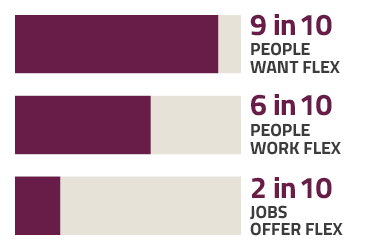
At the start of 2020, 9 in 10 people wanted to work flexibly, and 6 in 10 UK employees were lucky enough to do so. But the Timewise Flexible Jobs Index shows that less than 2 in 10 jobs were advertised with options to work flexibly.
A few months later, following the impact of covid and a massive shift to home-working for many employees, the dial barely moved in the jobs market. The ratio of flexible jobs rose slightly to 22%, or just over 2 in 10.
It’s important for the jobs market to reflect workplace practices on flexibility, to ensure equality and inclusion. Otherwise, how can flexible workers move jobs to progress their careers? And more importantly, if they become unemployed, how can they ever find their way back into work?
That dilemma is now truer than it has ever been, following the pandemic. The jobs market has been decimated this year, and the brunt of losses has been felt by people in low-paid jobs in retail and hospitality, where flexible working is common. Women with caring responsibilities have also been disproportionately disadvantaged, likewise older workers and those with health conditions. Flexible working is a necessity, not a luxury, for these groups.
Read on for the key findings of the Flexible Jobs market, or download the full report here.
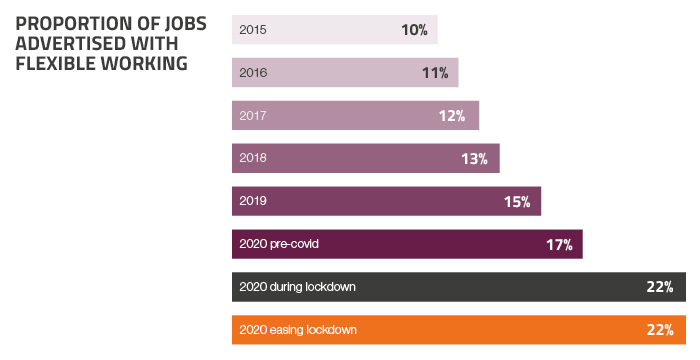
The proportion of job adverts offering flexible working has increased at a snail’s pace over the last 6 years, from 10% in 2015 to 17% at the start of 2020. During the national lockdown in Spring 2020, the rate increased surprisingly little – to 22%. Recruitment advertising is still failing to reflect what is happening in the workplace:
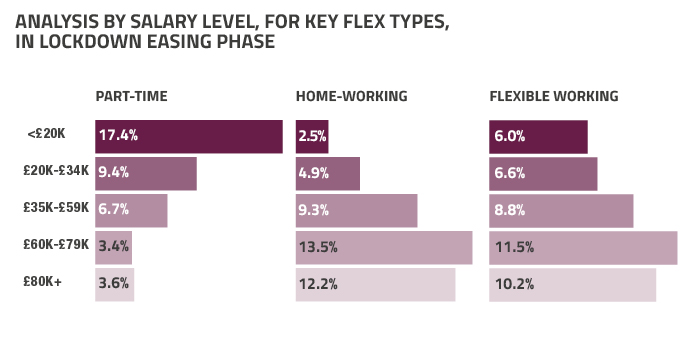
A fractured flexible jobs market is revealed by differences in the types of flex offered by salary level:
This two tier system of flexible haves and have-nots creates blocks in career progression for people who need to work flexibly. Workplace equality suffers, as women, carers, older workers and people with health concerns are disproportionately affected.
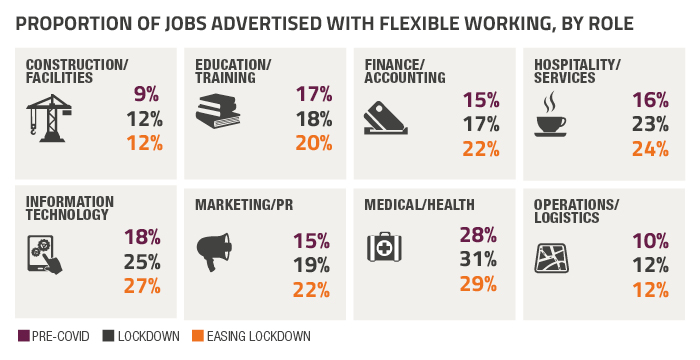
Availability of flexible jobs varies significantly by role. The pattern is similar to previous years, with medical/health well ahead of other role categories. Meanwhile male dominated roles such as construction lag well behind.
But a new pattern is emerging: since the pandemic, roles that lend themselves to home-working are beginning to catch up with health services. The biggest flex winner is IT. Finance, and marketing are also gaining ground. However, it remains to be seen whether the home-working increases will become a long-term feature.
Information on other role categories is available in the full report.
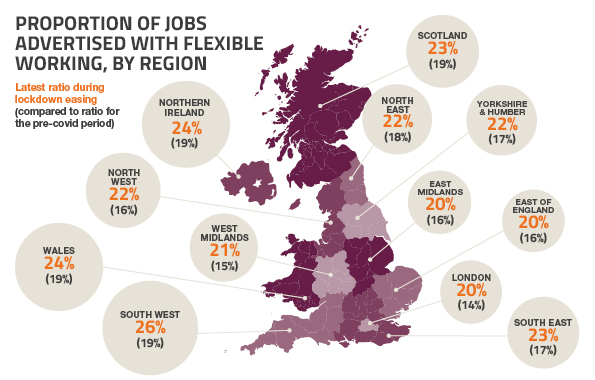
Rates of flexible recruitment are broadly similar across the UK, with the South West slightly ahead (26%) while the East of England, East Midlands and London bring up the rear (all on 20%).
Recruiting flexibly can help employers who want to encourage greater equality and inclusion in the workplace. It also means you’ll reach out to some great talent that you would otherwise miss.
Basically, employers need to strive to echo in their recruitment what is happening in their workplaces. This means advertising more roles with flexible working from the point of hire.
It’s helpful if job adverts can be as transparent as possible about which forms of flexible working are possible for the role. You might consider reduced hours (part-time), home-working (or a blend of home-working/workplace), flexible shifts, flexible start and finish times, or other options such as compressed hours or annualised contracts.
There is no one-size-fits-all flexible working pattern, but there is always a way to offer employees more input and control. Even in frontline roles.